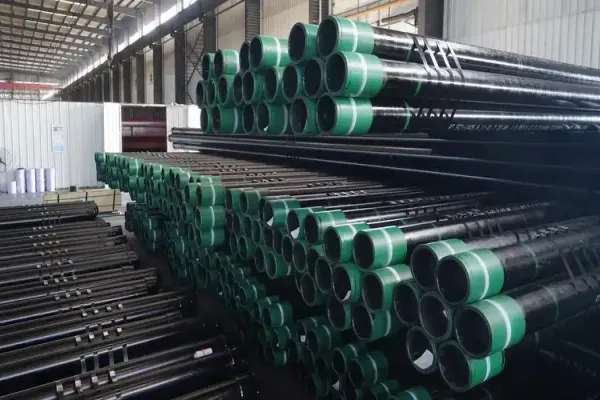Oil casing and tubing are essential components in the oil and gas industry, used to transport oil and gas from underground reservoirs to the surface. Their longevity is critical to the safe and efficient operation of oil wells. In this article, we will explore the lifespan of casing and tubing, the different materials used in their construction, factors affecting their durability, and best practices for storing them to extend their service life.
1. What is Casing and Tubing?
Casing is a pipe installed in a well to maintain its integrity, prevent collapse, and protect the wellbore from contamination. It serves as a structural support to ensure the safety of the drilling process. Tubing, on the other hand, is the pipe through which the oil and gas flow from the reservoir to the surface. Both are crucial in the extraction process and must be durable enough to withstand harsh conditions.
2. Types of Materials Used for Oil Casing and Tubing
The materials used in oil casing and tubing are designed to handle various operational and environmental conditions. Common materials include:
Carbon Steel (J55, N80, L80, P110): These are the most common materials used for casing and tubing. J55 is typically used in low-pressure conditions, while P110 is used for higher-pressure wells.
Chromium Alloys (3Cr, 9Cr, 13Cr, 22Cr): These alloys are designed to resist corrosion caused by CO2 and H2S, which are often found in sour gas and oil fields.
Special Alloys (90SS, 95SS): Stainless steels like these are used for environments with high levels of corrosion and extreme temperatures, providing superior durability in harsh conditions.
The material selection for casing and tubing is primarily determined by the well's specific operating conditions, including the presence of corrosive elements like sulfur, CO2, and H2S.
3. Factors Affecting the Lifespan of Casing and Tubing
Several factors influence the lifespan of casing and tubing, including:
Corrosion: The most significant factor affecting the lifespan of casing and tubing. Corrosive gases like H2S and CO2, as well as external environmental factors, can cause rapid deterioration of steel. The use of corrosion-resistant alloys and proper coatings can significantly extend their lifespan.
Pressure and Temperature: The operating pressure and temperature of the well can impact the integrity of the casing and tubing. High pressure and extreme temperatures can accelerate wear and tear.
Well Conditions: The type of formation and the specific chemicals present in the well fluid also affect the longevity of the casing and tubing. Sour gas wells, for example, require more corrosion-resistant materials.
Maintenance and Inspection: Regular maintenance and inspections are essential to identify wear or damage early. Proactive measures like cleaning and treating the steel can help prevent issues before they cause failure.
4. Expected Lifespan of Casing and Tubing
Given the diverse materials and operational conditions, the lifespan of casing and tubing can vary widely. On average:
Steel Casing and Tubing: Under favorable conditions and with proper maintenance, steel casing and tubing can last anywhere from 20 to 50 years. Steel used in high-pressure or corrosive environments may have a shorter lifespan unless treated with protective coatings or alloyed materials.
PVC and Concrete Casing: These materials can last up to 50 years or longer in favorable conditions, especially when free from external corrosion and physical damage.
It’s important to note that the effective lifespan of casing and tubing also depends on their condition over time. Regular wear, corrosion, and operational stresses can shorten their lifespan.
5. Best Practices for Storing Casing and Tubing
Proper storage is critical for preserving the integrity of casing and tubing. Storing them incorrectly can lead to corrosion, physical damage, and reduced lifespan. The following storage guidelines are essential:
Location and Environment: Casing and tubing should be stored in clean, dry areas, away from harmful gases, dust, or chemicals. Ensure the storage area is well-ventilated, and weeds or other debris should be cleared from the ground.
Avoid Contact with Corrosive Materials: Casing and tubing should not be stored near corrosive materials such as acids, bases, salts, or cement. These substances can cause significant damage to the steel.
Proper Stacking: Large steel items, such as casing pipes and steel plates, can be stored outdoors. However, smaller items like steel wire, small-diameter casing, and thin-walled pipes should be stored indoors in a well-ventilated area to prevent rust and corrosion.
Covering and Protection: For smaller steel products, including thin-walled casing, it's essential to cover them with protective materials such as tarpaulins. This helps prevent moisture accumulation and exposure to environmental elements.
6. How to Maximize the Lifespan of Casing and Tubing
To extend the lifespan of casing and tubing, regular inspections and proper maintenance are essential. Consider the following strategies:
Corrosion Protection: Apply coatings or inhibitors to prevent rust and corrosion, particularly in corrosive environments.
Routine Inspections: Conduct periodic inspections to detect early signs of wear, corrosion, or damage. Non-destructive testing (NDT) methods, such as ultrasonic testing, are effective for identifying issues before they become serious.
Monitoring Well Conditions: Monitor the pressure, temperature, and chemical composition of the well fluid regularly. Adjustments to the operational parameters may help prevent damage to the casing and tubing.
Timely Repairs: If wear or corrosion is detected, timely repairs or replacements should be made to avoid failure and extend the service life of the casing and tubing.

7. Conclusion
The lifespan of
casing and tubing depends on various factors, including material choice, well conditions, and maintenance practices. In ideal conditions, casing and tubing can last between 20 to 50 years. However, regular maintenance, proper storage, and proactive monitoring are essential to ensure their longevity. By selecting the right materials, applying best practices during installation, and performing routine checks, oil and gas operators can maximize the service life of their casing and tubing, ensuring the continued reliability and safety of their operations.






 English
English Español
Español بالعربية
بالعربية











 Phone :
Phone :  Whatsapp :
Whatsapp :  Email :
Email : 


